|
|
UV-Vis-IR Vertical Ellipsometer
|
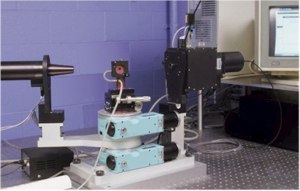
|
|
This commercially-built, fully automated ellipsometer provides high
precision measurements of the optical properties of any sample
over the wavelength range of 190 to 1700 nm. An integrated light
source/ monochrometer designed specifically for the system
provides an exceptionally bright, well collimated probe beam over
the entire wavelength range. An autoretarder allows both
transparent and opaque samples to be measured with equal
accuracy, and also is the key element for the generalized
ellipsometry mode, which can determine the optical properties of
anisotropic samples with arbitrary orientation. The ellipsometer
can be combined with the cryostat systems (providing variable
temperature measurements from 4.2 to 700 K), or combined with an
computer-controlled electromagnet (providing automated
magneto-optic measurements over the entire wavelength range).
|
|
|
UV-Vis-IR Convertible Ellipsometer
|
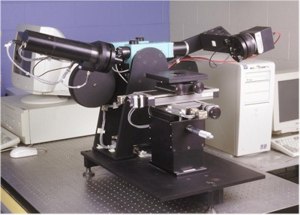
|
|
Essentially identical
to the Vertical UV-Vis-IR system, this ellipsometer can be
mounted on various ex-situ
or in-situ systems to
accommodate measurements of horizontal sample surfaces such as
liquids. It also provides highly accurate broadband (190 - 1700
nm) measurements for all of our insitu systems. With lenses
attached, the light beam for this system also can be focused onto
a 20 m m-wide area.
|
|
|
Broadband Infrared Ellipsometer
|
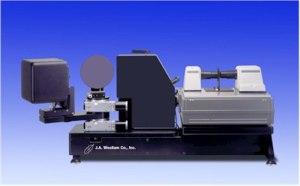
|
|
This infrared ellipsometer provides state-of-the-art
measurements of the optical properties from 1.25 to 40 um.
The rotating compensator configuration produces excellent data
from both transparent and opaque samples, and the system can
accommodate samples sizes from less than ¼ inch to 8 inches wide.
This is a very difficult instrument to produce: currently, there
are perhaps a few dozen wide-band infrared spectroscopic ellipsometers in the world,
fewer than five of those reside in the United States. Only two or
three other instruments in the world can match the wavelength range
and accuracy of this ellipsometer. This commercially designed and built instrument
is also an extremely stable, robust workhorse that can be (and often is)
operated 24 hours a day, seven days a week. The instrument is designed to
accommodate both variable temperature cryostats. Future improvements include
an upgrade to a generalized ellipsometry configuration that can handle anisotropic
samples of arbitrary orientation.
|
|
|
Far Infrared Ellipsometer
|
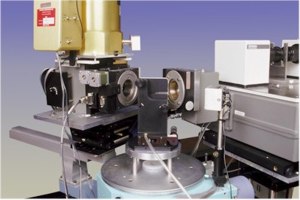
|
|
A detector consisting of a liquid helium cooled silicon bolometer
provides this infrared ellipsometer with a maximum signal-to-noise
ratio in the wavelength range of 14 to 100 um. When combined with the
Janis cryostat, this instrument is designed measure the far infrared
response of samples in the temperature range of 4.2 to 700 degrees Kelvin.
Using the same software and many of the same hardware components as the
Broadband IR ellipsometer, this specialized instrument fully integrates
into our data analysis system. Its generalized ellipsometry configuration allows measurements of
anisotropic samples of arbitrary orientation.
|
|
|
Magneto-optic Far Infrared Ellipsometer
|
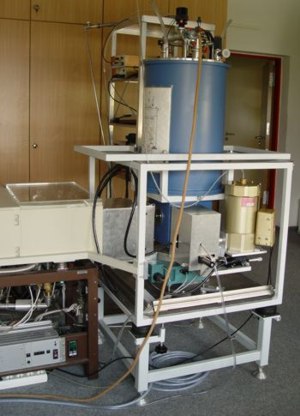
|
|
This unique system consits of a superconducting magnet cryostat (6 T)
connected to a customized far infrared generalized ellipsometer configuration for
measurements in the wavelength range of 14 to 100 um. It is the first experimental system
which allows the measurement of the optical Hall-effect in the far infrared frequency range.
Thereby, the anti-symmetric dielectic function tensor can be measured and the free-charge-carrier parameters
determined in a single optical experiment. The setup furthers allows the measurement of the
far infrared response of samples in the temperature range of 4.2 to 300 degrees Kelvin. (The system is operated
in cooperation with the University of Leipzig, Germany.)
|
|
|
Multiwavelength Ellipsometer
|
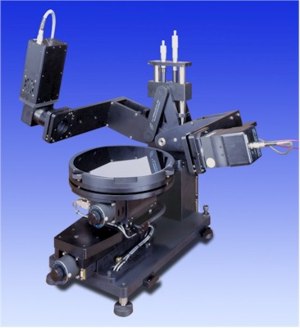
|
|
Multiwavelength ellipsometers acquire full spectra (all available wavelengths)
of ellipsometric data very rapidly. Though their spectral range is usually somewhat
limited compared to the ex-situ ellipsometers, they are especially well-suited for monitoring
of materials growth and processing. Obtaining the time dependence as well as the wavelength dependence
of the optical response significantly improves the ability to determine sample optical properties and
film thicknesses. Existing facilities make it possible for these instruments to monitor processes
on both sputtering systems, the electron beam evaporation chamber, the LEO simulation chamber, a
UV exposure station and a electrochemical process chamber. This flexibility strongly enhances our
research capability in many different types of material systems and processes.
The analysis of these data presents special problems associated with the complexity
of the information obtained; however, the inferences which may be drawn are often quite
extensive if the experiments are properly designed and data properly analyzed.
The rate of technology advancement within these systems is steep; the number of
wavelengths for which data may be obtained has, for instance, advanced from 12 to about
250 in the last five years. Other comparable advancements are being made in data
in the area of data quality. In fact, recent contributions to system design by researchers in
the CMOMR have aided the development of the M2000, the first of a new generation of
multi-wavelength ellipsometers. These feature higher data precision for a wider variety of samples.
The facility also possesses an 88-wavelength version (M88), which also provides in-situ monitoring of
optical properties from the mid-UV through the visible wavelength regime.
|

